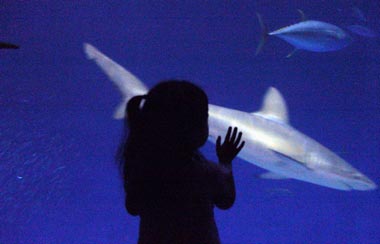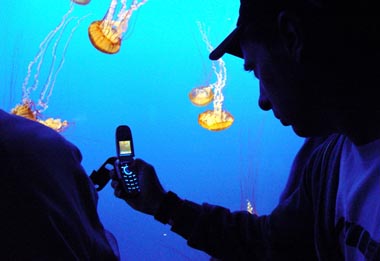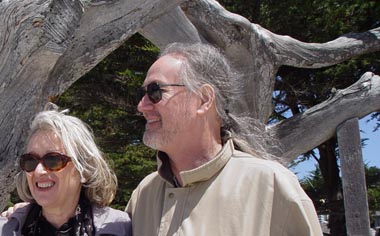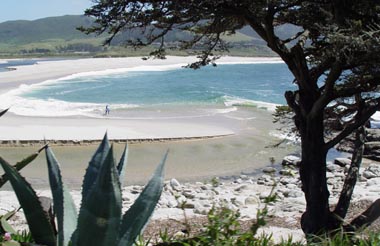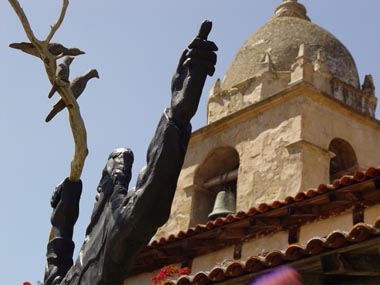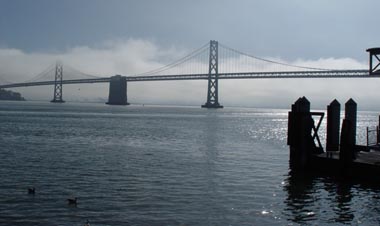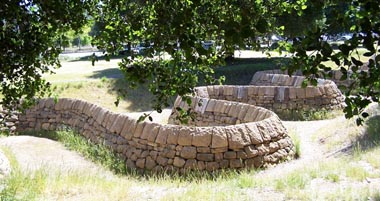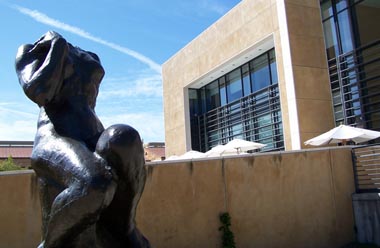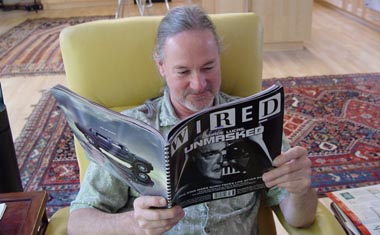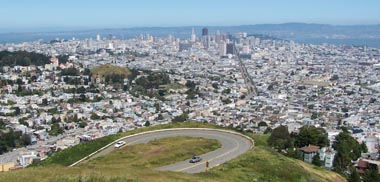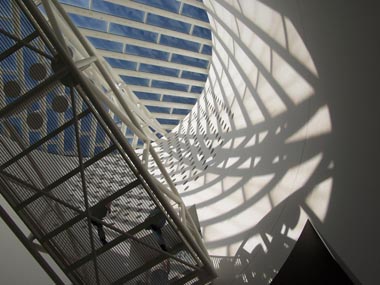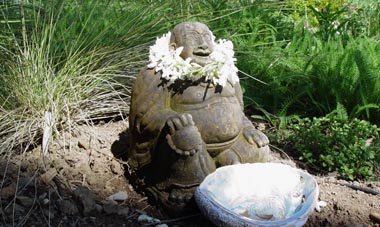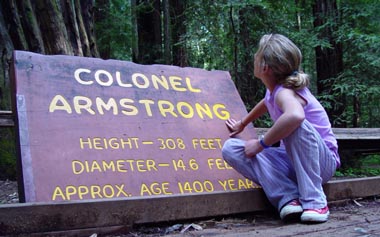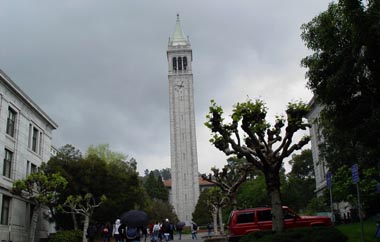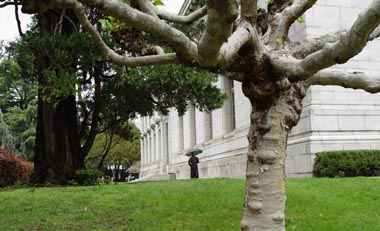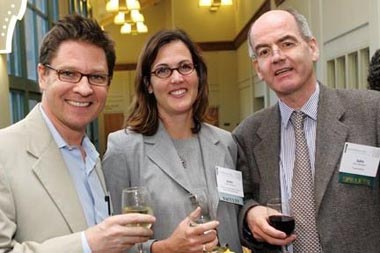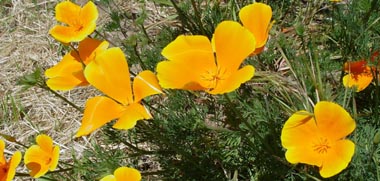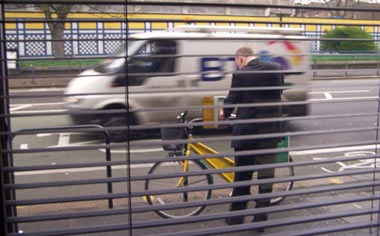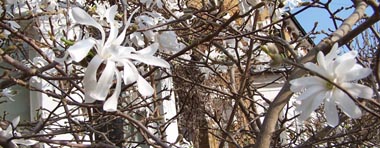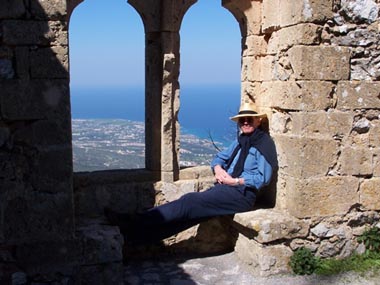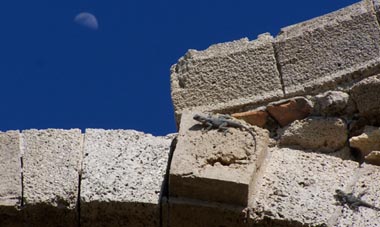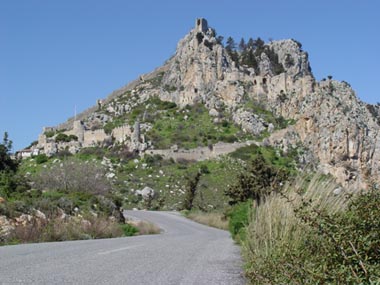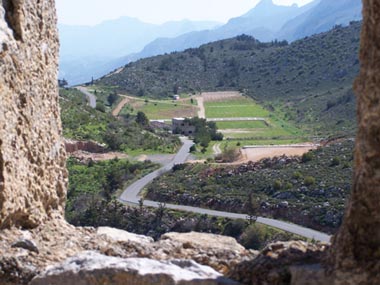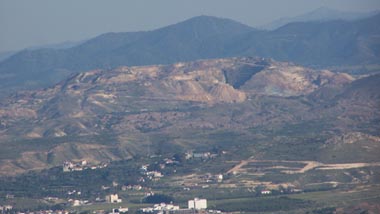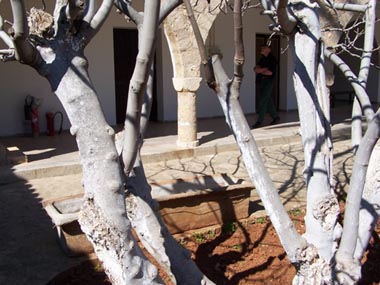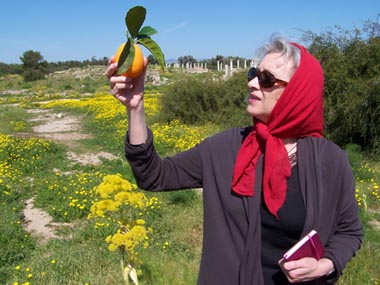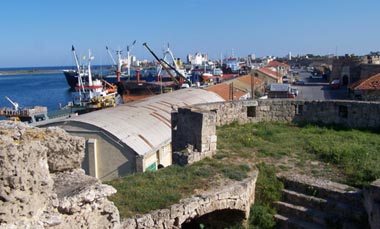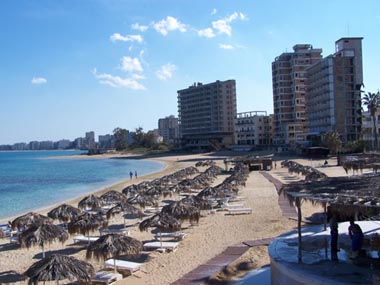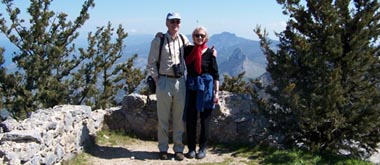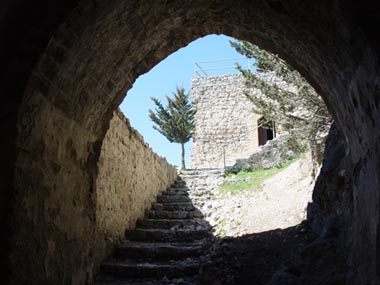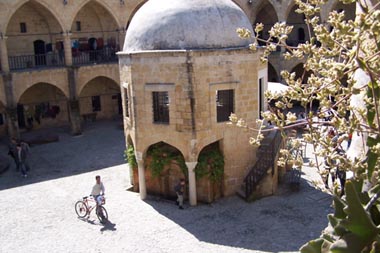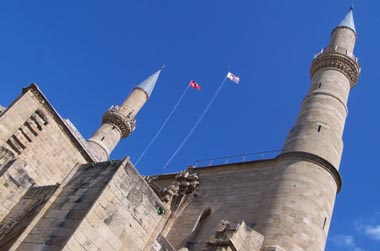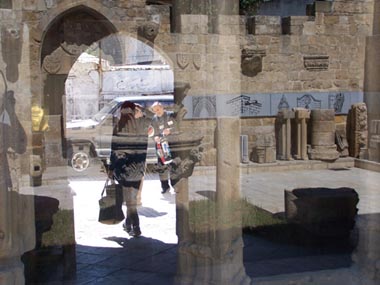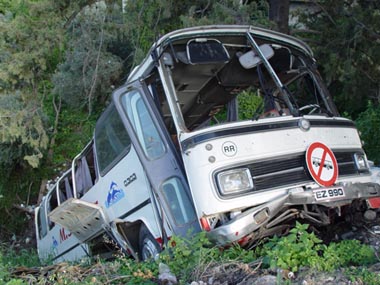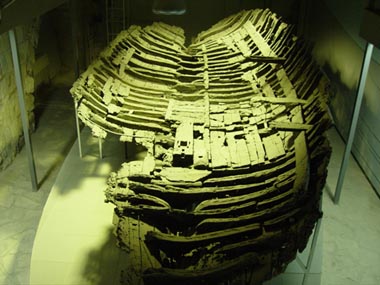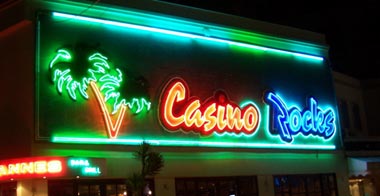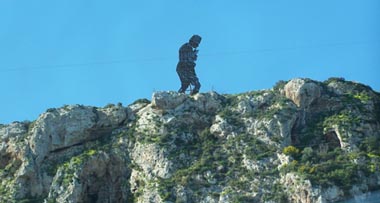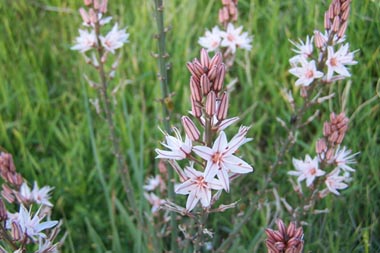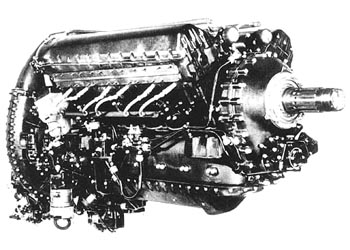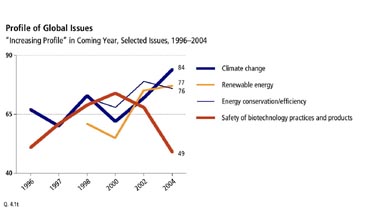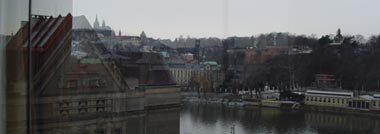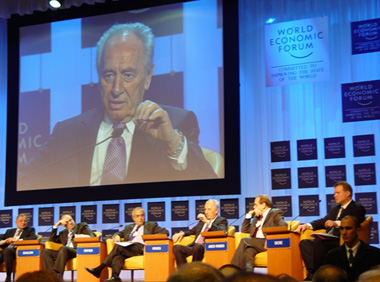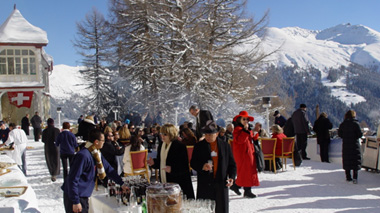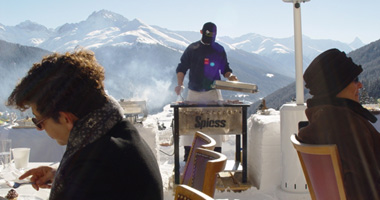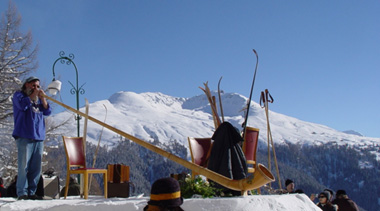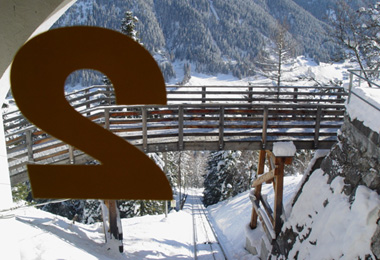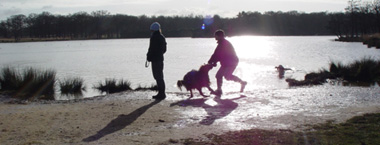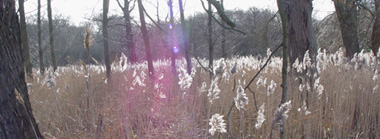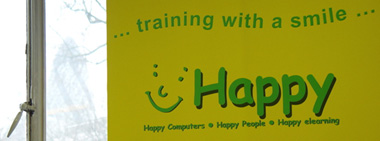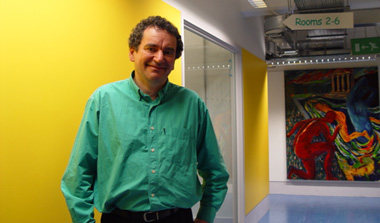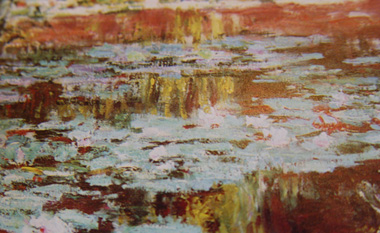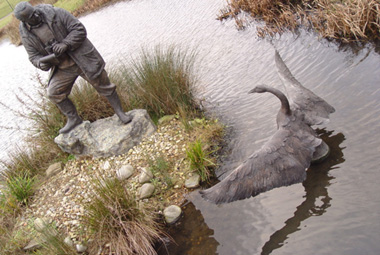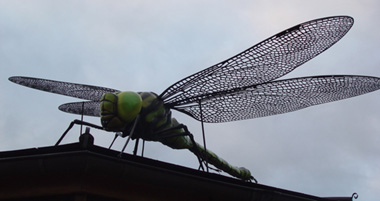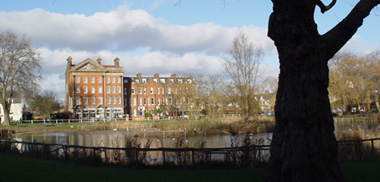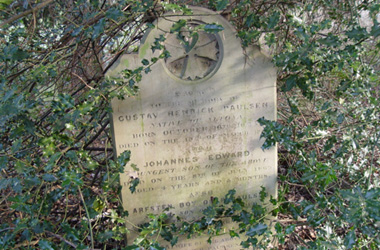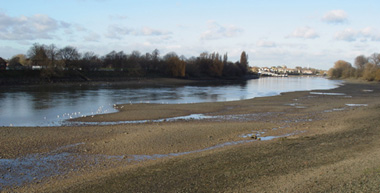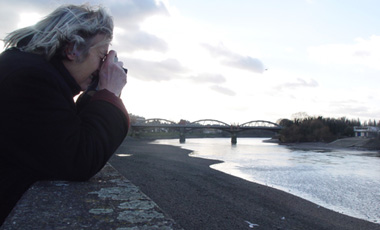Tuesday, May 31, 2005
TOTEMIC WELCOME
Among other things, did a phone-in programme for CBC today. Then, this evening, out by bus to the UBC Museum of Anthropology (http://www.moa.ubc.ca/) for welcome reception, surrounded by totem poles, masks and canoes. Second time I have been to the Museum – and I genuinely can’t wait to have a serious opportunity to see more of the 35,000 objects stored there.
Surrounded by all that glass, though, I couldn’t help wondering what will happen when the next mega-quake hits this coastline. But was soon distracted by the First Nations troupe who had the entire audience of WWF-ers pretending to be eagles, frogs, killer whales and wolves (my end of things). First opportunity I had to howl all day – and welcome opportunity to see the late Bill Reid’s astounding Clam again (http://www.billreidfoundation.org/).

The eagles include the Lieutenant Governor, in white jacket
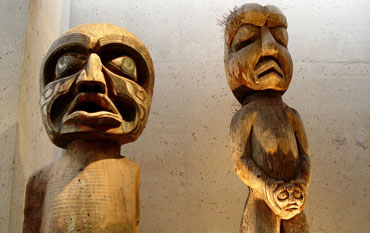
A sense of angst
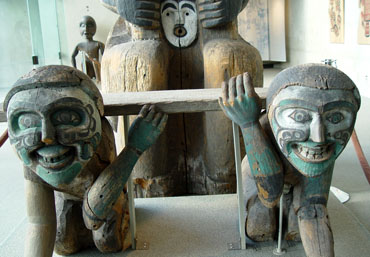
Not sure what’s going on here …

But he seems agitated …
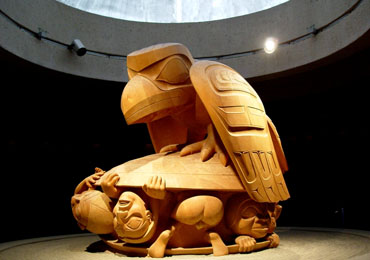
As are the people squeezed in Bill Reid’s clam
Monday, May 30, 2005
EU IMPASSE
I’m getting used to viewing major events in the UK and EU from a considerable distance, as with the recent Uk elections (when I was in Australia and New Zealand) and yesterday’s French vote on the EU Constitution (where I got the results in Vancouver).
On one level, it’s obviously a big blow to the process of European integration, as currently defined. But, on another level, it seems to me that it really is time to revisit our definitions of the EU. Quite apart from the schadenfreude associated with seeing President Chirac so mightily embarassed – having said late last year that any country that voted against the Constitution should immediately leave the EU – it is increasingly clear that we need a less technocratic, more engaging vision of what Europe’s role in the world could be. For me, being a counterbalnce to the US doesn’t quite qualify. And we also need a new generation of leadership, fit for the 21st century.
Jacques Chirac, at 72, isn’t quite as bad as the glaced politicians who graced the rostrum of the Kremlin before the collapse of Communism, but his self-serving style of politics is pretty much the polar opposite of what we now need. His regal response to the vote, at least as quoted here on the West Coast, underscored the problem: “France has expressed itself democratically … it is your sovereign decision, and I take note.”
The bigger issue, though, is the collision between two opposing views of Europe. The first, embraced by Britain, Ireland and Eastern Europe, views the EU primarily as an opportunity space, with the main emphasis being on creating a more efficient market. The second view, most energetically embraced by the nations that were the epicentre of two world wars, or European civil wars as some have styled them, sees the EU primarily in terms of an emerging set of pan-European social institutions.
It’s clear that the French are alarmed about the prospects of the first approach undermining the ‘European social model’ enshrined in the second approach. And they aren’t alone in that, as the Dutch vote will probably show. But my recent visits to Asia, particularly China, persuade me that it won’t really matter how much Europeans fret about their social models if Asia continues along its current economic trajectory. Ensuring a radically more efficient European market is the only way to ensure a viable future for Europeans – and I would argue that we should let the EU’s institutional forms emerge from those needs and processes, not the other way around.
SATISH KUMAR AS CASTAWAY
Was thrilled to hear Sue Lawley interview Satish Kumar of Schumacher College (www.schumachercollege.gn.apc.org) and Resurgence magazine (www.resurgence.gn.apc.org) on Radio 4’s Desert Island Discs before I flew to Vancouver today. Some years back, my erstwhile colleague Max Nicholson did one too, but I missed it because I was travelling. Today, though, you can hear these things via the BBC website (http://www.bbc.co.uk/radio4).
Satish picked a number of my favourite musicians, among them Joan Baez, Bob Dylan, Leonard Cohen and John Lennon. But, as I told him by email this evening, he picked ‘Imagine’ where I would probably have picked the Beatles and the more muscular ‘Revolution’. The Beatles and their (ultimately ill-fated) Apple venture were an early inspiration for my own later move into the world of business.
Saturday, May 28, 2005
FAY GODWIN, JOYCE LAMBERT & DEREK RATCLIFFE
Three obituaries in recent days mark the passing of more of the pioneers of environmental conservation.
First was Joyce Lambert, who died on 4 May. She had astounded Britain when she discovered that the Norfolk Broads were man-made, rather than natural. They were the result of extensive peat-digging, particularly between the twelfth and fourteenth centuries. One of my first articles for New Scientist, in the mid-1970s, featured the Broads, which was where I first came across her work. I still remember trailing my fingers in the water as I was taken around the Broads by Dr Martin George, the NCC’s Regional Officer, and saying how wondrously green the water was — and being told that what I was admiring was pollution, eutrophication!
Second, on 23 May, Derek Ratcliffe died. His obituary appears in today’s Times. I knew him when I sat for several years on an Advisory Council for the old Nature Conservancy Council (NCC) and he was the NCC’s Chief Scientist. He is probably best remembered for his research showing the links between the use of organochlorine pesticides, particularly DDT, and the decline of birds of prey, among them peregrine falcons and sparrowhawks. I well remember long talks with Max Nicholson — a founder of the original Nature Conservancy – about that period of what he had dubbed ‘The Environmental Revolution’. But when I came across Ratcliffe he was probably best known as the architect of 1977’s A Nature Conservation Review, often described as a ‘Domesday Book’ of Britain’s most important natural features.
And third, Fay Godwin’s death is reported in today’s Guardian. An extraordinary photographer, I first came across her work when she was producing the pictures for a book on The Ridgeway which was published by Oliver Caldecott at Wildwood House, where Elaine was working in the mid-1970s. Godwin was an ardent landscape conservationist and her images helped switch me on to the country’s ancient stone circles.
HEIMAT
Last night, I watched BBC4’s reshowing of the first programme in the first series of Edgar Reitz’s Heimat TV series, which I last saw in the 1980s. Astounding. The second series, which I saw many more of, was hugely reminiscent of the time I spent in Hamburg in the early 1970s. The other German TV series which I was completely absorbed by when it was first shown was Wolfgang Petersen’s Das Boot, the extraordinary inside story of the U-boat war against Britain, released in 1981 (www.dasboot.com).
Friday, May 27, 2005
KINGSTON READERS’ FESTIVAL
Politics and the media were the focus of a ‘Question Time’-style panel session I was involved in last night at the Kingston Readers’ Festival (www.kingston.ac.uk/krf or www.kingston.gov.uk/arts). Held at the Tiffin School, the event was chaired by Donald MacCormick, former presenter of BBC TV’s Newsnight programme. Other panellists were: Brian Cathcart, Deputy Editor of The Independent on Sunday; Diane Coyle, Visiting Professor of Economics at the University of Manchester, with whom I sit on the RSA Council; and Kevin Maguire, political columnist and Associate Editor on the Daily Mirror.
Great audience, lively debate – and, having dreaded the thing, found that I rather enjoyed it. And it forced me to think about things – among them the EU Constitution, the future of the UK educational system, and who I would like to run each of the major UK political parties – that I don’t normally devote much attention to. On the last point, my reply ran along the following lines: SustainAbility is able to succeed internationally in large part because we are diverse. Last time I looked, our team of less than 25 people was made up of 10-11 nationalities. But in the latest UK Election, the Conservatives ran a campaign targeting immigrants that made me wonder whether they had any sense of what it will take for the UK to compete in globalized markets. And, while I am sure our immigration policies could be better designed and managed, their strident campaign almost made me ashamed to be British.
But I sent a note today to the British Ambassador in South Korea, who hosted the dinner for me when I was in Seoul, and noted in passing that his hospitality and the quality of the discussion that evening had made me proud of the British diplomatic corps. So, it seems, my pride in my national identity is a matter of swings and roundabouts. And, having been brought up to some degree outside the UK, I have always felt slightly ill-at-ease with the notion of Britishness, feeling instead a layered sense of identity: English – and a Londoner for 35 years; European; and Terran, something that is reinforced every time I fly around the planet. But the best of the British identity, which involves accepting kinship with other nationalities (the Irish, Scots and Welsh, plus the myriad of contacts from the Empire, colonial and Commonwealth eras) is something I find I’m warming to.
Monday, May 23, 2005
ENVIRONMENT FOUNDATION GOES BICS
Great meeting of the Environment Foundation Board of Trustees today, during which we conclude that our joint venture with The 21st Century Trust will involve developing annual Consultations at St George’s House, Windsor Castle, focusing on China, India, Brazil and South Africa. The first, on China, to be held in October.
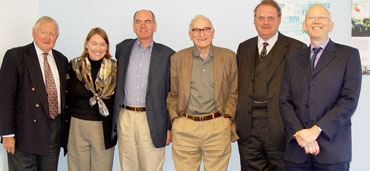
Tim O’Donovan, Jane Nelson, me, Sir Geoffrey Chandler. Dr Malcolm Aickin, John Lotherington (21st Century Trust)
Friday, May 20, 2005
CHINA DEVELOPMENT BRIEF
One of the more interesting visits Kavita and I made in Beijing was to China Development Brief, run by Founding Editor Nick Young (www.chinadevelopmentbrief.com). We had a very pleasant lunch in the courtyard of the Brief’s compound in the sort of jerry-built hutong (an ancient city alley or lane) that is fast disappearing from many areas of the city. Among other things, we discussed the Brief, which was launched in 1996, and such reports as their latest publication, 250 Chinese NGOs: Civil Society in the Making. More information from their website.
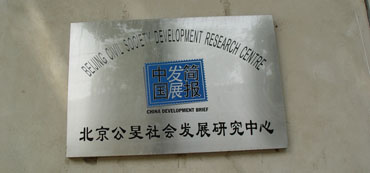
Writing on the wall
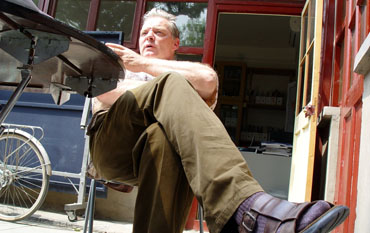
Nick Young
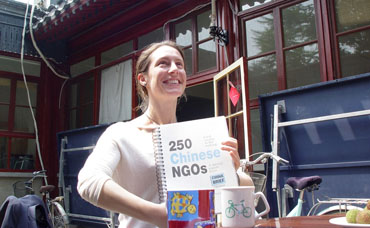
A major report, on Chinese NGOs, held by Robyn Wexler

Kavita and lychees
EYELESS IN FORBIDDEN CITY
Kavita and I start out early to see the Forbidden City, only for me – after our being caught in endless jams – leaving my glasses in the taxi. Went through the Forbidden City in a state of high agitation and grief, but was nonetheless vastly impressed by the scale and timelessness of the place.
Afterwards, we came back to the hotel to meet Jerry Lixhe of LEAD and New Ventures, after which we sped off in another taxi to a huton, back street lunch with Robyn Wexler and Nick Young of China Development Brief (www.chinadevelopmentbrief.org). Then on to a WWF event, hosted by the ad agency Ogilvy, where I do my last presentation. Then on to a China-India colloquium, which proves better than Valium, so we head back to the hotel.
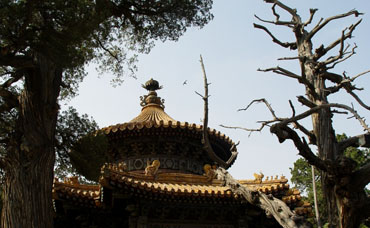
In the background, hundreds of energetic schoolchildren …
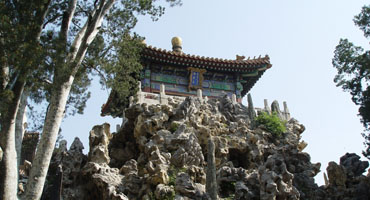
Where was this originally quarried?
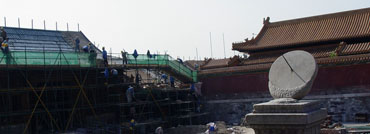
Time passes slower as repairs continue on ravages of Time
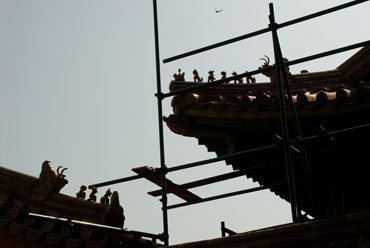
Roof friezes
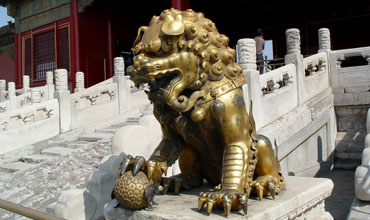
Symbol of power
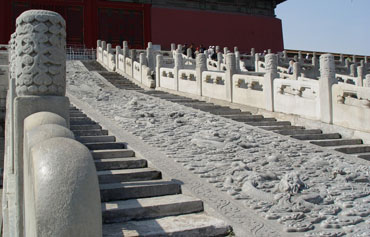
The stone for this carving came in on a road made of ice
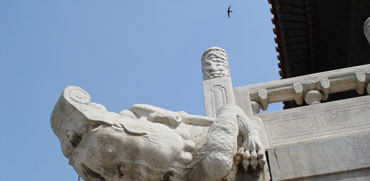
Swift
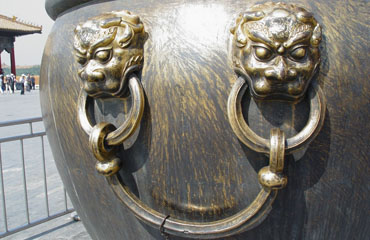
Gurning urn
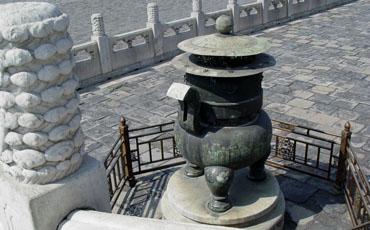
Historic fire brigade
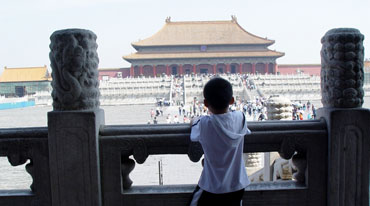
His past – and future?
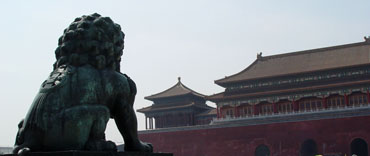
Brooding
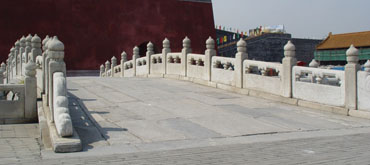
Bridge
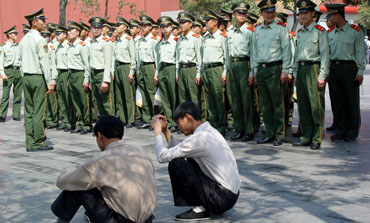
Soldiers and passers-by
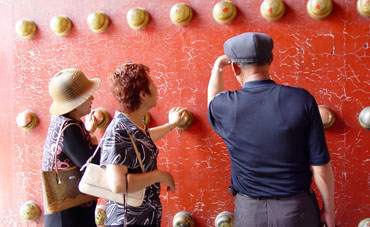
Is this good luck?
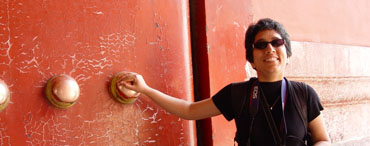
Kavita thinks so …

Mao
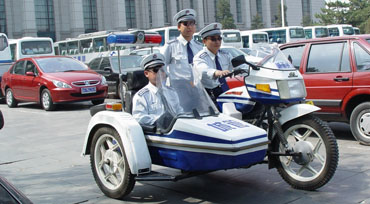
Three policemen in tricycle.
Thursday, May 19, 2005
THE DAY ENDS IN APRICOT BLOSSOM HAMLET
What a day! Kavita and I spent the morning with Jeanne-Marie Gescher and Natalie Cade of Beijing-based Claydon-Gescher Associates, or CGA (www.cga-ltd.com), who had pulled together 6-7 people from Chinese NGOs and universities. A fascinating set of insights, followed by lunch with Jeanne-Marie and Natalie.
Then a monstrous ride in a taxi to the wrong end of Beijing, in solid state dynamics traffic, in an attempt to find a group of AIESEC students who had set up a workshop. After an hour and a half of getting thoroughly lost, our hosts managed to talk the taxi driver in by cell phone – and we spent a frustratingly short – but nonetheless intriguing and stimulating – 30 minutes with some 30 or so students.
Then into another taxi, which got us back to the hotel a little late for the car that was meant to be taking us to dinner with Minister Pan Yue, Vice Minister with the State Environmental Protection Administration (SEPA) – http://www.zhb.gov.cn/english/chanel-1/chanel-1-end-2.php3?chanel=1&column=1
Had liked him tremendously when we sat next to each other at a Shell dinner last night. He had asked Kavita and I to dinner this evening, and now had us driven to the outskirts of Beijing, past the Summer Palace, in a government limousine with six different horns, each of which we used, as we blazed at warp speed towards the Western Hills. We were met and accompanied by a SEPA Deputy Director, Wang Qian, who is as good an ambassador for China as you are likely to find.
The dinner was at the ‘Apricot Blossom Hamlet’, in the Beijing Botanical Garden, near the ‘Fragrance Hill’, where we are joined by Vice Minister Pan and Dr Shu Qing, Deputy Director-General. I enormously admire what Vice Minister Pan and his colleagues have been doing, with SEPA energetically pursuing polluters and shutting a considerable number of projects down to force greater attention to environmental issues. A very courageous politician.
All in all, a quite extraordinary meeting of minds – and the most sophisticated vegetarian repast I have yet eaten, including bird’s nest soup, though I think our Chinese friends would have much preferred meat. In the process, we drank ‘Daughter Red’ wine, which apparently is buried in a ceramic urn when a girl is born and dug up and drunk – with plums dropped in – when she turns eighteen. I found myself wondering what sort of world – and what sort of China – a newborn girl would find if a bottle buried today were to be dug up in 2023?
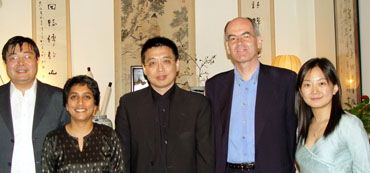
Dr Shu Qing, Kavita, Vice Minister Pan Yue, me, Wang Qian
Wednesday, May 18, 2005
RED SHIFTED IN BEIJING
Fairly energetic day, happily with Kavita (Prakash-Mani) now alongside, starting with session with Shell, then on to Fortune 500 Global Forum to do my session on the roles and responsibilities of multinationals (with David Cunningham, President of FedEx’s Asia Pacific Division, Jim Harkness of WWF, Xue Lan, professor at Tsinghua University, all moderated by Marc Gunther of Fortune). Louis Camilleri, Chairman and CEO of Altria, the fags-to-foods group, drops out at the last moment.
The red-shifted race continues – after several cars fail to arrive at Diao Yu Tai State Guesthouse, – with high-speed car drive to a lunchtime session across town where I am due to talk to 70-80 people invited by Shell and the China Business Council for Sustainable Development. Then also speak at dinner with Shell, state oil companies, people from embassies and Pan Yue, Vice Minister of the State Environmental Protection Administration. He has been taking a unusually aggressive line with high-impact developments, stalling at least 20 until they tackled a range of environmental issues.
Fascinating man – and gives me a degree of hope that some of China’s environmental problems can be tackled. But we were also told today by Heng Hock Cheng, Chairman of the Shell companies in China, that China has to build power production capacity each year equivalent to the total UK grid capacity! The scale of the challenge is phenomenal. We were also told that before the Olympics draconian measures like shutting down many boilers and many factories will be taken to clean up the air, plus seeding the skies with silver nitrate, to settle out the gunk!
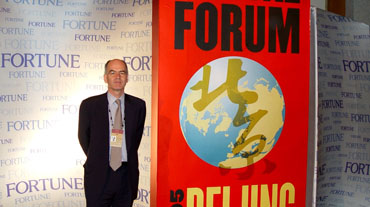
Pre-panel session
Tuesday, May 17, 2005
TIANANMEN SQUARE
After the Temple of Heaven, consenting adults were bussed across to Tiananmen Square, where we were offered drinks on the rostrum overlooking where the massacre of students happened in 1989. I didn’t drink, but silently toasted the aspirations and courage of those extraordinary people – exemplified by the young man with the shopping bags who stopped that platoon of tanks in their tracks. Some of the buildings around the Square are very reminiscent of the megalomaniac construction attempted by President Ceaucescu, who paid for his manifold sins in front of an impromptu firing squad that same year – events I covered in my published diary of 1989, A Year In the Greenhouse (Gollancz, 1990).
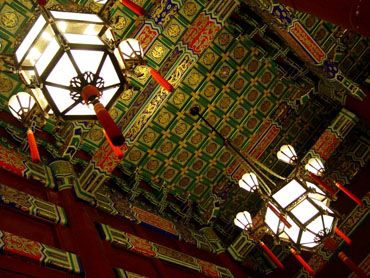
Ceiling lights
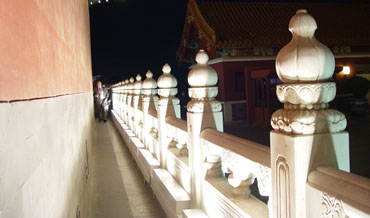
Balustrade
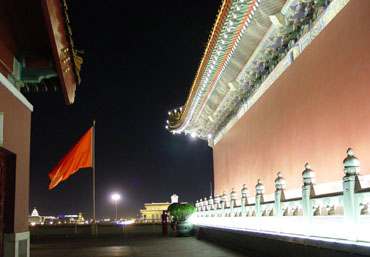
Flag
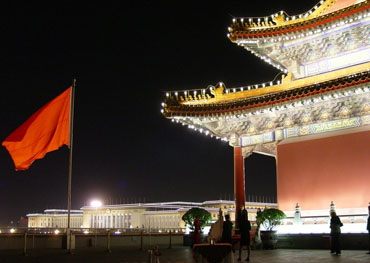
Great Hall of the People in the distance
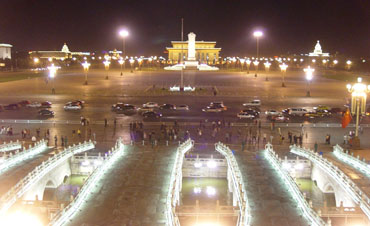
Tiananmen Square ablaze
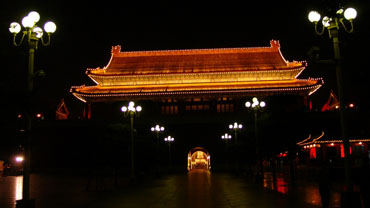
Can’t wait to see this place in daylight
TEMPLE OF HEAVEN
Fly (originally typed ‘fry’, perhaps because everyone at Narita encouraged me to “have a good fright”) in to Beijing from Tokyo. Due to speak at a session of the Fortune 500 Global Forum, titled ‘China and the New Asian Century’. Met at the airport by Antonius Papaspiropoulos and driver – and bags come through at lightning speed.
After dropping off stuff at China World Hotel, I take a taxi to the Diao Yu Tai State Guesthouse, or at least that’s what I ask for. Am taken to the Daioyutai Hotel instead, where they seem to know nothing about the Guesthouse, even though it’s only a (fairly large) city block away. After all sorts of confusions, I get to the Guesthouse in the end, register, and then find it’s already time to head back in busses through the afternoon traffic to the St Regis Hotel, to await embarkation for an evening at Temple of Heaven.
The Temple turns out to be literally out of this world, with a fairly dramatic light show and very impressive dinner – though I have to keep ducking and weaving to avoid the endless meaty treats put in front of me. And it’s even harder than usual because each diner has a young, impressively costumed attendant standing just behind them – although they don’t attempt to force-feed me.
I find myself sitting betwen the CEO of a speciality oil products company and the CEO of a Hawaiian property company, both of them pretty substantial concerns (the oil company’s annual revenues are $7 billion) – and both Paul and Allen are informed and thoughtful on sustainability issues. But Allen and I spend much of the time talking about history, particularly that of the Vietnam War, where he served during those crucible years. His wife, also at the table, is Vietnamese and her father was one of the last senior officers out – finally deciding to leave when he heard that the Communists were executing officers in front of their men. The plane before his was shot down and his crash-landed in Thailand.
One real high point for me was the high-energy flights of swifts that shot back and forth across the assembled heads during the early stage of the evening. Reminded me of cycling home to Barnes on summer evenings, when the swifts come bombing down the street at you, mouths open, and shrieking like maniacs. The avian equivalent of Hell’s Angels. By contrast, the musicians playing around the Temple were like something from the Elysian Fields, China-style.
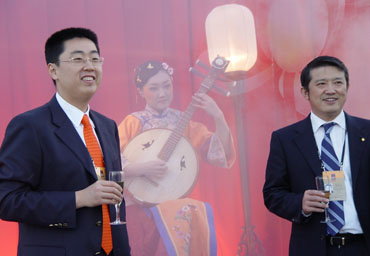
Musicians behind screens line approach to Temple of Heaven
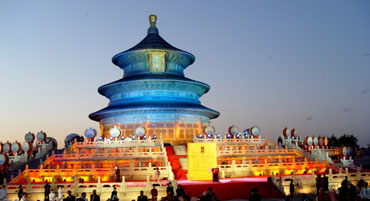
The backdrop
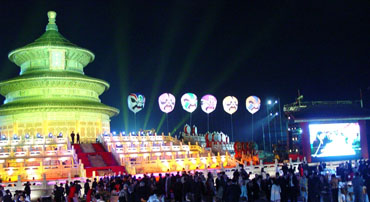
Lasers
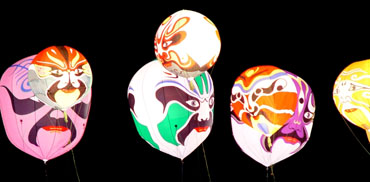
Balloons
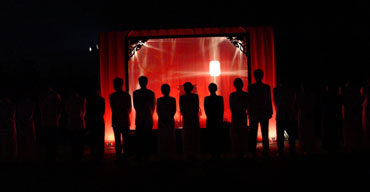
Young people lining exit route
Monday, May 16, 2005
FUJITSU: THE POSSIBILITIES ARE INFINITE
After the fish market, Tomoo and I did an hour-long interview and then were collected for the drive across to the Fujitsu Research Institute (FRI) conference I keynoted this afternoon. The session was chaired by Professor Haruo Shimida, Chairman of FRI. Panellists were: Kimie Iwata, General Manager at the CSR Department of Shiseido, the cosmetics company; Seiichi Ueyama, General Manager of the Corporate Citizenship Department at AEON, the retail group; Masanobu Katoh, Corporate Vice President at Fujitsu; and Kiyoshi Masuda, General Manager of Toyota’s Environmental Affairs Division. An excellent event, with some good questions afterwards.
Then we were driven to a Fujitsu centre opposite Hibiya Park, to be presented with the Fujitsu vision of the future, ‘netCommunity’ (http://e-japan.fujitsu.com/nc/). The Fujitsu motto is ‘The Possibilities are Infinite’, and the exhibition is designed to show the myriad ways in which Fujitsu technology – from palm print readers to RFID tags – can promote a better society. I am afraid I asked a number of ‘Big Brother’ questions, which was somewhat in the spirit of some my comments this afternoon. For example, when commenting on the Toyota presentation, I warned that although they may talk of sustainable mobility solutions, for car companies the almost uniform answer to the question of what ‘sustainable mobility’ might be is some form of car. I also noted that the idea that car ownership might reach saturation in China fills me with horror.
And then I had to quietly turn down foie gras sushi this evening at dinner, apparently something of a culinary innovation here. I imagine I will be persona non grata from now on …?
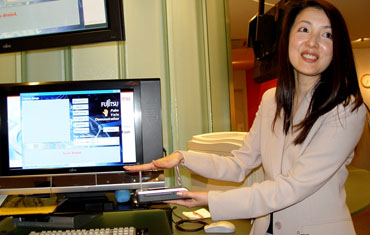
Palm print technology
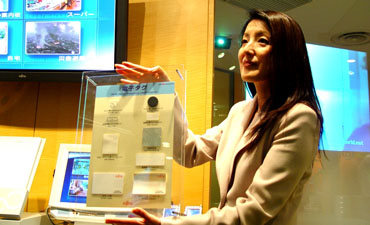
Have you tried our RFID tags?
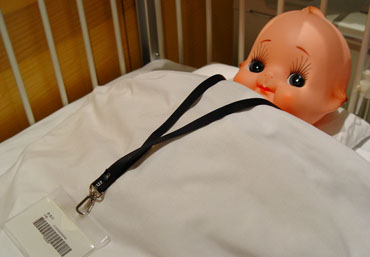
Marked from birth
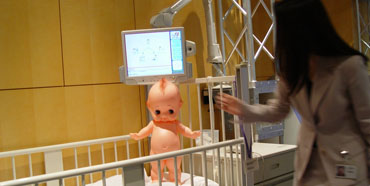
Something about baby worries me …
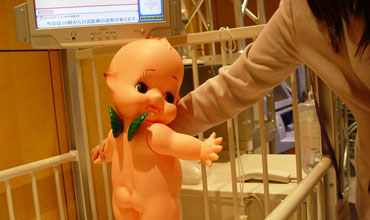
Ah, of course. He/it has wings!
TOKYO FISH MARKET
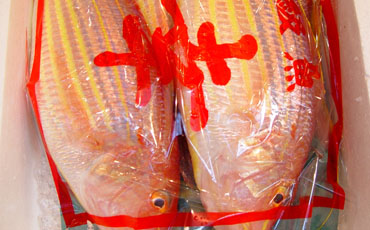
Did I know you?
Tomoo and I make an early morning visit to Tokyo’s Tsukiji fish market, a first for us both. Earlier, Tomoo and Judy had forwarded me a link to an Observer article on the implications of the nature and scale of Japanese fish consumption for the world’s oceans:
http://observer.guardian.co.uk/foodmonthly/story/0,,1453356,00.html
One of the most striking lines from the piece, by Alex Renton, was from a fish conservation poster in the Misaki fish market, featuring a smiling fisherman and a haiku:
Shining ocean
Is a big mirror
Which reflects our future.
True, but unfortunately the reflections suggest a pretty dire future for oceanic fish, for this extraordinary fish market and for fish consumers, both in Japan and elsewhere.
Take the bluefin tuna. As Renton puts it: “The bluefin is the black truffle of the tunas: mysterious, rare and stunningly expensive. Its raw belly meat provides the greatest otoro, the fatty tissue that is the most prized for sashimi and sushi. This gourmet’s distinction has been unfortunate for the fish, making it ‘severely endangered’: the Atlantic variety of bluefin is likely to be the first tuna species that will become effectively extinct. But, absurdly, the price of this luxury has collapsed because the market is glutted. That same quality bluefin tuna, from the same fishing ground, raised 2,250 yen a kilo on the Misaki quayside two years ago – maybe twice as much five years ago. ”
We have failed, again and again, to police the world’s oceans. As Renton concludes: “It’s a documented and recognised global disaster, but one we can do nothing about. No multinational mechanism exists with the muscle to beat the wallets of the fish-eaters.” Not sure what we can do in this area, but came away feeling SustainAbility should be doing something.
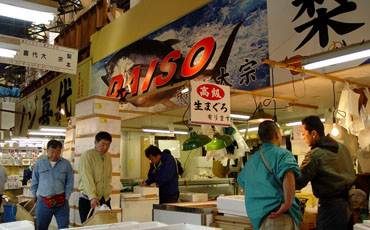
Retail fish market
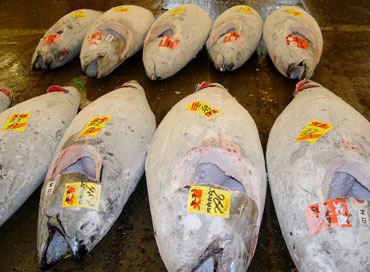
Last tuna from morning’s auction
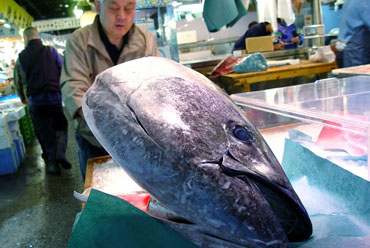
Tuna head
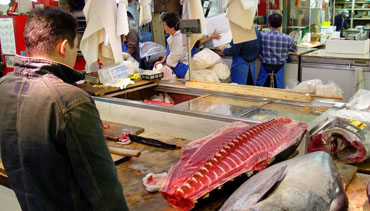
More tuna
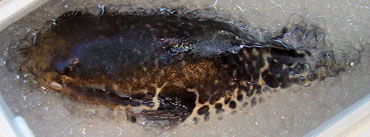
Fugu, the deadly delicacy, contains a toxin 1200 times more lethal than cyanide
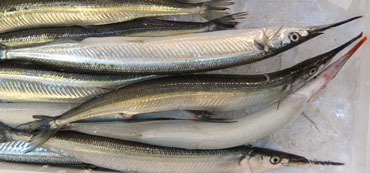
Some form of garfish?
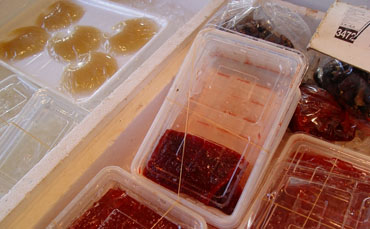
Eco-crimes: shark’s fin and whalemeat
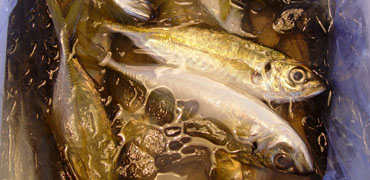
Where are you from?
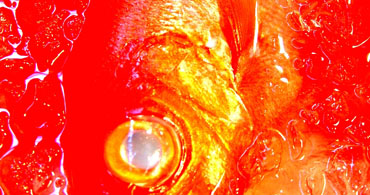
Fading, but the colours are amazing
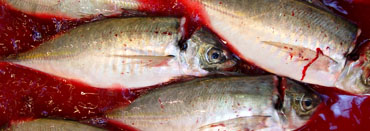
Swimming in a sea of blood

These guys again
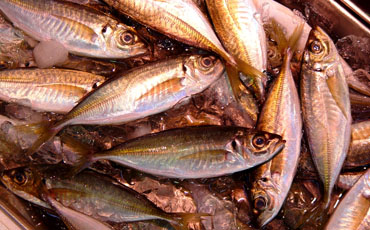
Shoal on ice
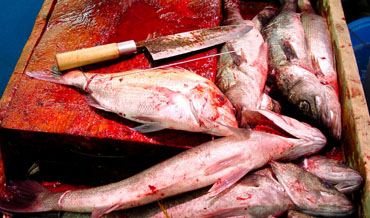
The sharp end
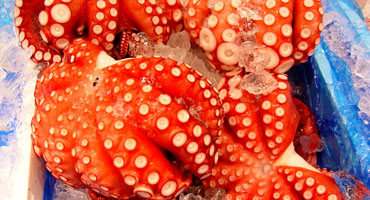
Octopus
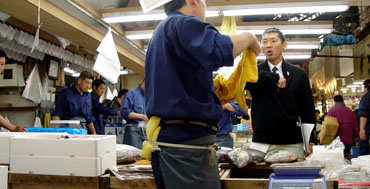
And, in the end, we drive it all …
Sunday, May 15, 2005
PICASA, THUNDER AND BLENDED VALUE
One of the great joys of recent days was my – perhaps somewhat belated – discovery of Picasa 2, the image management software now offered by Google. Geoff Lye at SustainAbility had mentioned recently that he found it hugely helpful, so I downloaded it yesterday (free) from www.picasa.com onto my ThinkPad. The first thing it does is to trawl through your hard drive to find all the images – and it was amazing to see images I had used years ago surfacing, like so many coelacanths. Easy to use, pretty much akin to what I have been using on my Mac for several years, and hugely recommended.
A day largely spent tapping away in my hotel room, sketching out an invited paper for California Management Review on the blended value agenda, which I’m co-authoring with Jed Emerson (who coined the blended value term, see www.blendedvalue.org) and Seb Beloe of SustainAbility. At one point in the afternoon, there was an enormous series of crashes outside, which at first I thought was an earthquake – but which turned out to be a thunder storm.
Saturday, May 14, 2005
‘CRANE’ AND BULLET TRAIN

Heron stalks …

Tabloid headline: ‘Gotcha!’
Well, maybe it was a white heron rather than a crane, but as I walked around the Hama-rikyu Gardens this afternoon a water bird caught its prey. At one stage, this was effectively the family garden of the Tokugawa Shogun, a place for leisure and duck hunting. The place was pulverised, however, by the Great Kanto Earthquake and by WWII bombing raids. A typhoon – ‘Kitty’ – also hit in 1949, the year I was born. Much of the gardens still seem in shambles, with diggers at work in various places behind ‘No Entry’ signs. And the moat around the gardens is rancid and foul-smelling, full of prams, haversacks and other rubbish – surprising in such a tidy city.
Soaring over the gardens is a glistening wall of skyscrapers, including the one where we had dinner the other evening. As I walk back to the hotel, bullet trains slide noiselessly through the backdrop. Then off to dinner with friends, their children and mother-in-law. Wonderful to see a Japanese family at home. Then driven home in – you guessed it – a Prius.

Bullet train: Ambitious Japan!
A DAVID IN JAPAN
Saying goodbye to Judy (Kuszewski) this morning, I was reminded of something that a number of the Japanese people we have met this week have said, often with a slight sense of awe. They simply cannot imagine how SustainAbility, which we openly explain is a global midget of between 20 and 25 people, can have had such an impact in Japan. Indeed, there often seems to be a Wizard of Oz character to our reputation here.
The answers to the riddle, I suspect, are relatively simple. They include picking the right issues over the years, building relationships with the right partners, and coming here year after year. This must be my tenth or twelfth trip over the past 20 years or so. The interesting question as our interests expand to include countries like China and India is how we can build the capacity to invest similar – or greater – levels of effort across the wider region. This is something we will have to think about in greater depth when Kavita (Prakash-Mani) and I join Judy back in our London office, after our impending trip to Beijing.
Friday, May 13, 2005
E-SQUARE AND TACHI, A HUMAN PHENOMENON
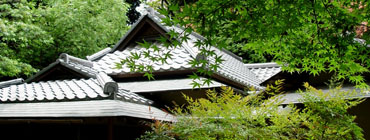
Tea ceremony house roof
This morning included a fascinating session for E-Square Inc., founded in September 2000 and dedicated to creating a ‘green economy’ (www.e-squareinc.com). Their CEO, Peter David Pedersen has visited our London offices several times, typically with a small group of Japanese companies in tow. Today’s session attracted around 30 people, from companies as diverse as All Nippon Airways, The Bank of Tokyo-Mitsubishi, Fuji Photo Film, Matsushita Electric Industrial, The Seiyu, Sekisui Chemical, and the charmingly named Unicharm Corporation. The theme of the session, for which I was providing the keynote, was ‘sustainable business models and branding’.
But by far the most charming feature of the event was Takashi ‘Tachi’ Kiuchi, one of Japan’s most iconoclastic businessmen. He picked Judy (Kuszewski), Tomoo (Machiba) and I up from our hotel in a chauffeur-driven limousine and took us to Kaitokaku, a huge grey house on a hill at the eastern end of the Tanakawa Heights – an area once famed as a place to view cherry blossom and the moon.
As Chairman and CEO of Mitsubishi Electric America, Tachi oversaw the company’s transition from the old to the new economy. He also championed a “living systems” approach to business that included rapid adaptation, financial transparency, openness, cultural diversity, executive positions for women and environmental sustainability. But he is perhaps best known in NGO circles for developing a breakthrough agreement with the Rainforest Action Network (RAN) to promote corporate sustainability.
Among other things, he is now Chairman of the Future 500 (www.globalff.org) and CEO of E-Square. Surfing the Net to find out more about him, I was not surprised to find (on the Forum for Corporate Conscience site, www.forumforcorporateconscience.com) that in his spare time he skydives, runs marathons, climbs Mount Fuji, rides his bicycle to the Future 500 HQ in downtown Tokyo and does 1600 push-ups a day.
On top of it all, he has a wonderful sense of humour. Indeed, one of the things I commented on during the Kaitokaku session was that the participants had been showing a great deal of humour as we ran around the table. And that, for me, has always been a good sign, suggesting that people are no longer in awe of the agenda, but are allowing a degree of playfulness to creep in – and this, in turn, potentially fuels creative, lateral thinking.
After the excellent lunch with the E-Square team and other participants, Judy, Tomoo and I walked around the gardens, among other things watching the huge trellised wisteria being pruned by a platoon of gardeners. The somewhat drear grey stone main house was designed by English architect Josiah Conder, but – following extensive damage during the wartime air raids – the interior was reconstructed from 1963. Commissioned by Yanosuke Iwasaki – who died the same year it was finished – the house was later used by the Mistubishi Company to entertain executives and staff.
The gardens also suffered post-war neglect, but things have been looking up. The 300-year-old wisteria produces huge blossoms each year, each some 24-24 inches long, indeed the remnants of these were being trimmed away by the gardeners as we watched. And in the rose garden, something like 1,000 rose bushes bloom all at once each year, which must be a spectacle.
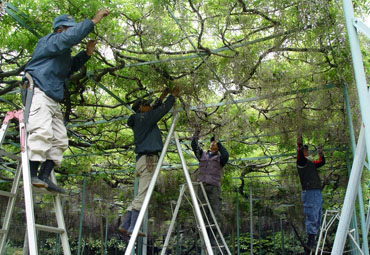
Wisteria gets a trim
Then we crunched across the carefully raked gravel to yet another taxi for the trip to the next session, this time with the Nikkei BP Environmental Management Forum. I did the speech, Tomoo translated, and – once again – CSR was on top of everyone’s mind. In this case, however, one key area of interest was how an initiative originally set up to tackle environmental issues could transform itself to handle the wider corporate social responsibility agenda.
Interestingly, a degree of angst was expressed by at least one major company about the way in which the questionnaires sluicing in from foreign socially responsible investment (SRI) funds increasingly feature a growing range of social issues, among them issues related to human rights. So, while apologising for possible political insensitivity, I explained why human rights are important even in developed countries like Japan, noting the presence of sizeable excluded populations in Japan – quite apart from the ongoing dispute with China over wartime atrocities carried out by the Japanese.
Later in the evening, Judy, Tomoo and I walk out into the city, drop into a small, convivial bar, and have a wonderfully relaxing supper – surrounded by end-of-the-week salarymen who get progressively livelier as the evening wears on – and the beer and sake flow. In the background, a cook throws the most extraordinary range of species onto the open grill, triggering great clouds of steam and sheets of flame. A speciality of the house seems to be huge fish-heads
Thursday, May 12, 2005
‘RISK & OPPORTUNITY’ LAUNCH
Main event of the day is the launch of the Japanese language version of our Risk & Opportunity report in front of 250-300 executives. Judy and I both speak, together with Daisuke Fukutomi, Director of Corporate & Government Ratings at Standard & Poor’s, our partners in the project – alongside the United Nations Environment Progamme (UNEP). I get hooked out of the session before Judy begins to begin the first of a series of five or six press interviews, most with photographers buzzing around like electric bluebottles.
Afterwards, we are taken out to dinner by people from the Japanese end of Ernst & Young. The Japan-as-predator theme continues in my brain as we are served with white clods of conger eel in clear broth, and the delightful waitress gaily tells us that the animal was killed but moments before for our dining pleasure.
What with the 90-minute interview I did early this morning for the Editor-in-Chief of Toyo Keizai magazine, I end the day feeling fairly hoarse. Toyo Keizai, who are 110 years old this year and describe themselves as the Japanese version of The Economist, are organising a major conference later in the year at which I am due to be one of the speakers. And then, from 22.30, do a 60-minute teleconference with the SustainAbility Board, with calls linking in from the West and east coasts of the US, the UK, Belgium and Switzerland. Highly productive.
Wednesday, May 11, 2005
PANASONIC’S FUTURE LABORATORY

I go bladerunner
We kick off the day at the Panasonic Center Tokyo, complete with photovoltaic cell-stippled roof, where the Matsushita Group spotlights its twin visions of ‘the ubiquitous network society’ and of ‘peaceful coexistence with the environment’. We meet Managing Director and Board member Hidetsuga Otsuru and several of his colleagues, before they take us around the exhibits. When I am subjected to a retinal scan, my retinas glow blue and I end up looking like something from Bladerunner. We also visit the ‘Future Laboratory’, where all sorts of futuristic machinery responds to every human whim. All utterly fascinating, but leaves me feeling somewhat uneasy. Odd sense that we dream of living in Star Trek luxury, but may end up back in caves rather faster than we can imagine.
Later in the day, I do a keynote at a Nikkei CSR Group session with 25-30 executives. Discussion, as ever, slow to start, so I end up giving 10-minute answers to the questions I do get, though this includes Tomoo (Machiba)’s translations. Companies present include Shiseido, Sumitomo Forestry, Sumitomo Mitsui Banking Corporation and Tokyo Marine & Nichido Insurance.
After drinks, Tomoo and I head off to dinner at Zipangu with two colleagues from Sony, Asako Nagai (who I first met when she worked with Ford in Detroit) and Hidemi Tomita, who I first met when he worked with Sony in Germany. We dine on the forty-seventh floor of a soaring Shiodome skyscraper, which soon has us talking about earthquakes. The trip down in an open, glass elevator is vertiginous – and, as my ears pop, I wonder if the same thing happened to those who fell to their deaths from the World Trade Center.
Wonderful meal, with the only hiccup being the arrival of carefully prepared servings of shark’s fin. I gently squawk and avoid, but the more I eat out in Japan, the more I have the sense of a mighty predator drawing in threatened species from around the globe. And the fate of dominant species in overtaxed environments was nicely spotlighted earlier in the day by the dinosaur scultpure rearing through the heart of the Panasonic Centre.
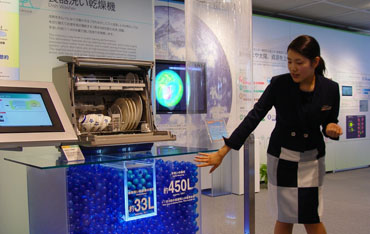
Eco-efficient mini-dishwasher
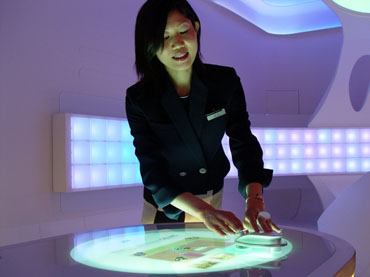
21st century luxury at finger-tip command

Tomoo sees future of transport

Judy views over-bed dream machine
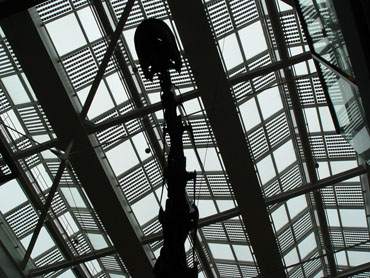
Dinosaur sculpture and solar cells
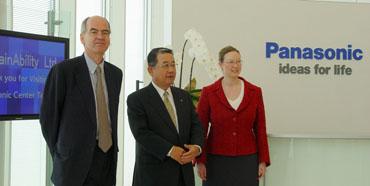
And so goobye: Elkington-san, Otsuru-san, Kuszewski-san
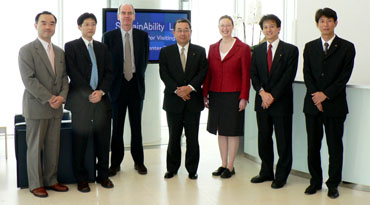
Our team: Tomoo (second from left), me, Judy
Tuesday, May 10, 2005
SPELL GINKGO

Spot the missing ginkgo. To my left: Mr Chung Haebong (Chief Executive Officer of Eco-Frontier), and to my right: Professor Byoung-Hoon Ahn (Korea Advanced Institution of Science and Technology Graduate School of Management).
One of the nice touches of this visit has been that Antonius Papasiropoulos of Shell came up with the idea of having a small golden badge struck for the occasion, in the shape of a ginkgo leaf (gingko also seems a permissible spelling). The point being that the ginkgo tree is a symbol of longevity in Korea – and has been around as a species for some 270 million years. By the end of the day, half Seoul seemed to be wearing them on their lapel. I’m normally not a great badge-wearer, indeed I avoid them like some lapel plague, but have rather enjoyed the sense of confraternity bestowed by this one.
Monday, May 09, 2005
CHEONGGYE CLEAN UP
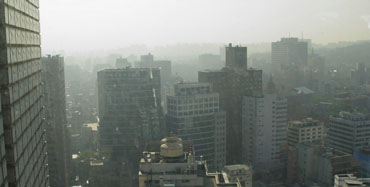
Seoul
Arrived very late last night, after storms reduced Hong Kong’s airport to chaos. When I had flown to Melbourne, BA lost one of my bags, whereas this time Cathay Pacific manages the feat of losing both. As longstanding colleague Antonius Papaspiropoulos of Shell Gas & Power kindly greets me and travels with me in the limousine into Seoul, where we’re staying at the Lotte Hotel, it’s around midnight and I’m wondering what it’s going to be like greeting Mayoral folk and the British Ambassador tomorrow in jeans.
In the background, the news continues to be about Pyongyang’s continuing threats to test a ‘plutonium-based nuclear device’, or bomb as Tom Lehrer long ago encouraged us to call such things. But, as someone says to me today, the further away from Korea you get the more fearful such issues seem – and vice versa. People here seem surprisingly relaxed about it all.
Today starts with a breakfast with Dr Colin McClune, Chairman of Shell Pacific Enterprises, and some of his colleagues, followed by a session with a number of Korean journalists, mainly from business magazines and media. Much interest in how Korea stands in relation to the rest of the world in relation to our issues. Well briefed by Shell, my hosts here, local NGO Eco-Frontier and Insight Communications, I was able to say that Korean companies have been making a fair amount of progress, albeit from a relatively low base.
Some 2,500 are now registered under the ISO14001 environmental standards, perhaps 50 have published environmental reports and seven – with Samsung SDI having jumped in first – have produced at least one sustainability report. Several banks have signed the Carbon Disclosure Project and a fair number of companies also now have product-related environmental certification. But my sense is that most of this driven by concerns about the environmental and sustainability concerns of major international markets and customers rather than by any great local appetite for sustainable development.
One of the most interesting meetings is a session with the Vice Mayor of Seoul. (The Mayor, we are told, has lost his voice but see below.) The Vice Mayor turns out to have an attractive sense of humour, as do many of the Koreans I meet. We talk about a number of sustainability-related issues, including air quality problems in the city and the ‘yellow dust’ problem caused in Korea by soil erosion in nearby China. But the subject that I was particularly interested in was the Cheonggyecheon restoration project, which involves removing an elevated stretch of highway and uncovering a long-buried stretch of stream in the city centre.
In some ways this is a matter of national pride, in that the environmental defects now being addressed reflected the exigencies of post-war reconstruction, at a time when Korea’s GDP per caoita stood at a mere US$100, compared to US$10,000 today. The Vice Mayor and I hover over maps of the scheme while photographers happily snap away.
Diplomatically, none of us mention the latest news: a second Vice Mayor, Yang Yoon-jae, has just been arrested as part of an investigation of the stream restoration project – and charged with allegedly accepting 200 million won (US$200,000) from a real estate developer, in exchange for relaxing height limits for a building due to be built alongside the stream. If proved true, this could be a major blow to the Mayor’s own presidential hopes. But, whatever the facts of the matter, the financial corruption charges should not blind us to the very real environmental and civic benefits of a project designed to clean up past ecological corruption.
By late morning, one of my bags – and my suit – turns up. So I am at last respectably turned out, though am still wearing an unfamiliar dolphin tie lent to me this morning by Colin McClune. One oddity: as we drive through the city today after one of two events I spoke at – a British Chamber of Commerce lunch at the Grand Hyatt Hotel and a ‘Sustainable Korea’ workshop organised by Eco-Frontier – someone points out that most of the cars here are white, off-white, pale brown, grey or black. The overall impression, coupled with the Eastern bloc aesthetic of much of the building, is dusty, workaday, drab.
By contrast, our dinner this evening with the British Ambassador, Warwick Morris, is a welcome respite in a small green oasis, complete with lawns and even a newly constructed – and thatched – bird table. Sadly, though, bird life is in short supply here, given the general hostility of the surrounding environment to wildlife. Many interesting conversations, but one in particular sticks in my mind – with Dr Chul-Hwan Koh, a profesor of marine biology and member of Korea’s Presidential Commission on Sustainable Development. Having spent seven years as a member of the European Commission’s Consultative Forum on Sustainable Development, which proved unwieldy at around 30 members, I am interested to hear that Korea’s version is having a real impact with 80 members.
In my small thank you speech as the dinner winds down, I note that the day’s conversations have encouraged me to do my homework on Korea when I get home. And the process is already starting. When I get back to the hotel, there is a new book on my bed: The Koreans: Who They Are, What They Want, Where Their Future Lies, by Michael Breen (St Martin’s Press, 1998/2004). Something to read on tomorrow’s flight as my bags no doubt go AWOL again.
Sunday, May 08, 2005
CATHAY PACIFIC TO HONG KONG
What do you do? we are often asked. One of the SustainAbility team recently found it all so hard to explain that he began telling people that he was a banker. But every now and then you get into a conversation where it’s easier. I had one of those today.
The day started in Melbourne and, if all goes well, will end in Seoul. Up at 05.15, after a much-disturbed night of riotous noise in the streets outside: post-football revels, I learned. The hotel’s Indian receptionist â originally from Hyderabad – said (despairingly) that this was pretty typical for a weekend. My taxi driver, originally from the Punjab, agreed. The back seat of his car was covered in the vile debris from previous passengers who, he sighed, were generally drunk. Not surprisingly, he wasnât enamored with Australian youth or sports culture.
Brilliant white banks of mist stand between trees, over river courses as the sun rises over the airport. I am flying Cathay Pacific to Hong Kong, then on to Seoul. Business class is bursting at the seams, with two travelers ahead of me being involuntarily downgraded because no-one is prepared to accept money to switch to Economy. Another sign of the growing importance of the ‘China trade’?
I find myself sitting next to a white-haired Australian farmer, traveling to China and Japan as part of a delegation from a dairy cooperative. They sell powdered milk and cheeses to Asia. He asks me what I do, and when I tell him, he regales me with some of the many issues the farming community now faces, particularly the long-running drought and incipient problems of soil salinization caused by irrigation. His farm’s water allocation has been cut back again this year, which makes life progressively tougher. Many people are leaving the land, though the fact that water rights are now tradable and they can sell their increasingly valuable allocations often helps ease the transition. He’s not at all sure that he will encourage his children to stay on the land.
We trade notes on some of the politicians I have met on this trip, among them Victoria Premier Steve Bracks, Deputy Premier John Thwaites and Treasurer John Brumby, and he comments that they are all more aware of environmental and other sustainability issues than their predecessors. But he wonders whether we are acting fast or effectively enough.
Our talk roams back and forth over decades. And, as it happens, today is my parents’ 58th wedding anniversary. As we head north over the old, scoured, arid wastes of the Australian outback, I find myself musing how all our issues will be seen 58 years from now, in 2063. I shall be long gone, of course, but I muse to my farmer friend that a world of 9-10 billion people is going to be radically different, with growing problems in such areas as climate change and human and livestock pandemics.
Rick Murray of Swiss Re used an extraordinary slide during our conferences this week which underscored the ways in which the impact of diseases such as foot-and-mouth, BSE and SARS already impact the insurance and reinsurance industries. Both Australia and New Zealand are now highly expert at biosecurity, with intensive checks as you land to ensure visitors don’t bring in diseases, but no system is perfect. And there will be those who intentionally introduce diseases as acts of terrorism or economic warfare.
In fact, one of the most interesting bets Wired magazine ‘Senior Maverick’ Kevin Kelly told me about when I visited him in San Francisco a few weeks back and we talked about the predictions open for wagers on the www.longbets.com website was that one million people would die in a single bioterror or bioerror incident in the first few decades of the 21st century.
Having read the latest issue of Scientific American on the flight up from Auckland a few days back, I would say that the chances were high. Scientists researching ice cores have found evidence of falling carbon dioxide and methane levels accompanying massive historic die-backs in the human population, as when 25-40% of the European population were killed by bubonic plague in Roman times, and again when similar proportions were killed in the Middle Ages. But perhaps most dramatic was the period of die-back of the pre-Columbian population of the Americas when the Europeans arrived, bringing with them diseases such as smallpox. Perhaps as many as 50 million died.
Sustainability may be hard to define, but that strikes me as one form of unsustainability.
THE MURRAY EDMONDS FLYING CIRCUS
This is the seventh time I have led one of Murray Edmonds’ Flying Circus tours of Australia and New Zealand – and it’s great to be on the road again with Murray and Dobrina – and with a wonderful new bunch of speakers. Here is a miscellany of images accumulated during the 2005 tour. Some say this was the best tour yet, but each tour has had its own strengths, joys and nail-biting moments. None of them, however, would have got airborne had it not been for Murray and Dobrina’s Herculean efforts (www.edmondsmgt.com.au).

I do not envy my neighbour’s plate
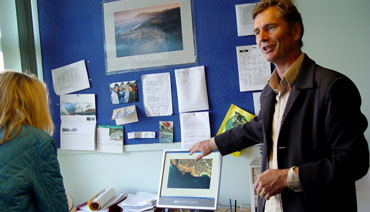
On our first day in Melbourne, we visit a school that is ‘going sustainable’
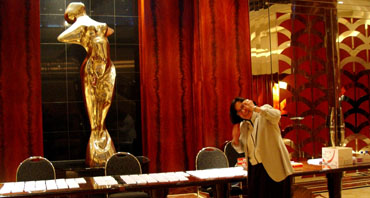
Dobrina awaits
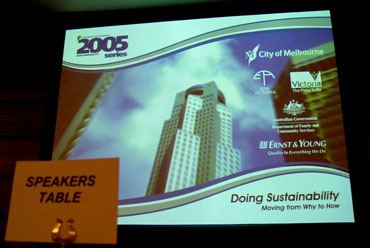
The Circus warms up on the runway
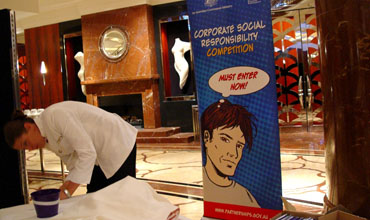
The CSR ‘crusade’ builds
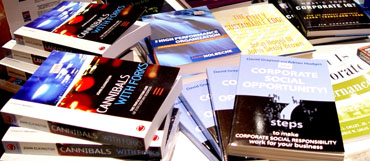
I lie cheek-by-jowl with David Grayson and Adrian Hodges
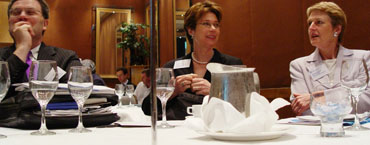
Peter Nelson (CEO, NZ Business Council for SD), Debra (Dunn), (Baroness) Barbara Young

Pamela Hartigan and Peter Nelson

Richard (Murray), right, in conversation
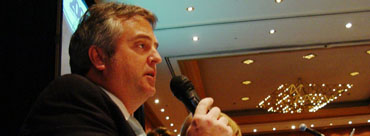
David Smith, CEO, IAG New Zealand

Murray and Debra unwind at the farewell dinner in Auckland

Red shoes: Kerry Griffiths, Principal Sustainability Consultant, URS, New Zealand
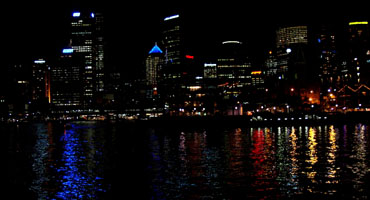
And so good night.
Saturday, May 07, 2005
THE COLOUR INDIGO

Rooftop reflections
One of the questions I had been sent in advance for a session with the Melbourne City Council team yesterday was an oddball: ‘What is your favourite colour?’
In preparing for the session – which mainly meant scratching my head on the flight across from Auckland – I had pondered this one at some length. The strange thing was that no particular colour fitted the bill. What came to mind, instead, was a sequence of diverse, mixed colourations: so, for example, lapis lazuli, rainbows, the Northern Lights. But, after discussion, I finally settled on some form of midnight blue, or – as Adam Briscomb prompted me to conclude – indigo. A blue-black, mysterious colour.
Primed with that thought, I was walking along Flinders Lane earlier on this afternoon, on my way to the National Galleryof Victoria (where I decided not to see the Adny Warhol ‘Time Capsules’ exhibition largely on the basis of the fact that I wasn’t sure I had enough money both for that and for a taxi tomorrow morning), when I spotted some delightfully variegated and colourful painted lines on the entry ramp to some sort of parking facility. As I took photographs, an Asian employee who was smoking outside the building approached me with a nervous smile and asked whether I was planning to sue someone?
Then I went swimming in the pool on top of the hotel, at several points swimming out over the street. And there were touches of indigo in the water, I thought. Since I can’t work out how to dimension the photos on my laptop, this is the only picture I will post until I get back.
Saturday, May 07, 2005
AM I AN INVASIVE SPECIES?
Don’t drop names, I say, unless you can drop a barrow-load. So here we go. I’m back in Melbourne, after a whistle-stop tour of Australia and New Zealand with our annual traveling circus. We have done major conferences in Melbourne, Sydney and Auckland, though I have also been doing a number of other speeches and sessions on the side, including a session for the New Zealand Business Council for Sustainable Development, a lunchtime session yesterday for Melbourne City Council (www.melbourne.vic.gov.au) and, last night, an Alfred Deakin Innovation Lecture (www.deakinlectures.com), in memory of one of Australia’s most influential historic politicians, in Melbourne Town Hall.
The theme of the Deakin session was ‘Using Capital Creatively’, the chair was Victoria’s Premier, Steve Bracks, and the other speakers included Bendigo Bank CEO Rob Hunt, Dr R.A. Mashelkar (Director General of India’s Council of Scientific & Industrial Research) and, though a paper presented on his behalf, Senator Aden Ridgeway, an Indigenous leader and Democrats Senator for New South Wales.
Once again, our 2005 conference tour has been organized by Murray Edmonds, a long-standing member of our Faculty (www.edmondsmgt.com.au). This year the focus has been on the practicalities of implementing sustainable development and our line-up has included (Baroness) Barbara Young, who runs the UK Environment Agency, Richard Murray, who is Chief Risk Strategist for Swiss Re, Debra Dunn, senior vice-president at Hewlett-Packard (HP), Pamela Hartigan, who is Managing Director of the Schwab Foundation for Social Entrepreneurship, and two people from IAG, the Australian insurance group, Sam Mostyn (she toured with us in Australia) and NZ IAGCEO (are you keeping up?) David Smith, who joined us in Auckland. I have been enormously impressed by the way that IAG are embedding a range of corporate responsibility and sustainability-related priorities.
Before coming out, I did an interview with George Dallas, who heads the corporate governance practice at credit-risk-raters Standard & Poor’s (S&P), which I brought with me in the form of a DVD and which we have shown at each of the conferences. It has gone down very well – and can be seen on the SustainAbility website. Note, incidentally, that George and I weren’t in the same room when the filming was done – we were on different continents, filming at different times, so I was interviewing an empty chair.
Among other folk I meet again as we travel round: Ros Kelly (a former federal Environment Minister in Austrlaia, married to the CEO of Westpac Bank, David Morgan) and, in Auckland, Ann Sherry, who is Westpac’s CEO in New Zealand. Ros reminds me, when we meet in Sydney, of the time – some years ago – when she invited me to dinner with David and some of his Westpac colleagues. She often remarks that this was a key milestone in the evolution of Westpac’s sustainability thinking.
This is the seventh time I have done the Oz-NZ tour; last year I couldn’t make it and my place was taken by ex-New Zealand Premier Mike Moore. Originally, in 1998, the focus was on environment, but the agenda opened out rapidly thereafter. Indeed the triple bottom line concept, which SustainAbility originated in 1994, has exploded in Australia and New Zealand – a bit like such introduced species as rabbits and cane toads in Australia and possums in New Zealand.
I’m still pondering whether to try swimming in the pool here at the Adelphi Hotel, a pool which is apparently cantilevered out from the hotel’s roof, over the street, so you can swim over the transparent bottom and see pedestrians walking around many floors below. But, while I’m sure the perspective would be interesting, I suffer from vertigo and discretion may well get the better of valor. And this trip is already proving all sorts of bottom-up, top-down and inside-out perspectives that provide more than adequate compensation.
Three things that have been borne in on me are these:
First, the extraordinary impact that SustainAbility’s work has had in different parts of the world.
Second, the way in which sustainability issues are now penetrating the political debate, both on this side of the world and in the UK – where Tony Blair is pledged to bring climate change into the agendas of his EU and G8 presidencies, while the Conservatives had threatened to eviscerate Barbara’s Environment Agency and to drop the just-introduced Operating & Financial Review (OFR) requirement for companies, one of the most interesting recent advances in corporate governance legislation.
And, third, the way that markets are beginning to pick up on the social and environmental priorities that make up the sustainable development agenda. Debra Dunn noted that HP now wins contracts each year worth several billion dollars where the project criteria include social and/or environmental specifications. And, she added, that area of business is growing at 30-50% a year.
Oh, and a final thought. Our addition of Pamela’s social enterprise component this year has gone down a storm. The ‘can do’ attitudes of social entrepreneurs chimes in very powerfully with the ‘it’s time to walk the talk’ theme of the 2005 tour.
BLAIR, ERUPTIONS AND EELS
Well, Blair – along, presumably, with his pledges to bring climate change onto this year’s G8 and EU Presidency agendas – is back. But his significantly reduced majority – and the fact that he has tapped Gordon Brown as his successor within the next Parliament – raise a forest of question marks over his future effectiveness. But at least the Conservatives aren’t in and energetically disabling Barbara Young’s Environment Agency or removing the newly introduced Operating & Financial Review (OFR) requirement, both things they had promised (threatened) to do.
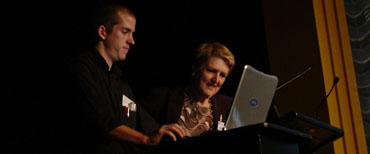
A world away, Barbara tees up in Melbourne
Now that the blasts of hot air are over, we can settle back to politics as usual. Meanwhile, today’s Australian Financial Review reports on a blast of 200 degree steam which erupted here a few weeks back. It was produced as part of attempts to exploit geothermal energy from the arid northeeastern corner of South Australia – by drilling four kilometres down into hot granitic rocks thought to contain twelve times as much energy as the fossil fuel reserves of the North-West Shelf. Apparently, these are the hottest rocks of their sort known worldwide other than beneath volcanoes.
Which reminds me of a conversation last night with Victoria’s Deputy Premier, John Thwaites, after a dinner atop the city’s ANZ Tower. He had just flown in from the Mount Eccles region, where he had visited an area where indigenous people some 8,000 years ago had cut into basaltic lava flows to divert local water flows and, by creating a series of wetlands, constructed a series of elver-rearing ponds. The spectacular wraparound views from the ANZ Tower and that blast of superheated steam the other day may have been pretty impressive, but the ponds (and the nearby clusters of stone-built homes) underscore the fact that the aboriginal peoples were often a great deal more sophisticated than many imagine. I thought I had been knocking off most of the places I still wanted to see in the world, among them northern Cyprus, but people just keep adding to the list!
Thursday, May 05, 2005
TALL POPPIES
In the final session of the Auckland conference, Professor Brian Springett once again raises an issue that has surfaced a number of times as we traveled around – that of the ‘tall poppy syndrome’. The problem is that people who excel in Australia and New Zealand tend to be cut down. Indeed, as Brian puts it: ‘There’s a ruddy great mowing machine operating.’ Given the importance of generating waves of successful social entrepreneurs, this potentially poses a major challenge. Interestingly, Pamela (Hartigan)’s presentations have addressed the issue of which cultures around the world support entrepreneurship – and which don’t.
Brian and Delyse Springett part-hosted my first visit to New Zealand. When I ask Delyse this evening, at an end-of-tour dinner at the No. 5 restaurant in Auckland, when that was, she says it was in 1995. Thank heavens for external memory modules. That time, I was speaking at a sustainable tourism conference in Wellington. Air New Zealand flew Elaine and I out first class – the first and only time I have flown first class – and Gaia came with us too, traveling steerage at our own expense.
Typically, I had brought only summer clothes and we arrived in Wellington in the midst of their first snowstorm for 40 years. When we eventually crossed to South Island and started to drive south, we were turned back by the police, who said the roads were impassable. In the event, we discovered the delights of Farewell Spit and of whale-watching off Kaikoura. Most impressively of all, however, we pitched up at a winery in the Marlborough district late at night, to find it closed for the winter. It turned out to be owned by Jane Hunter, a well-known New Zealand vintner. She opened up her restaurant just for us, lit a huge fire and made us feel wonderfully at home.
When we finally flew out, after a visit to the hot springs of Rotorua, Gaia appeared in the first class lounge at Auckland airport as a post-Apocalyptic vision, wearing dreadlocks, paratroop boots and finger-drawn facial markings of Rotorua volcanic mud. Luckily, four or five minutes later, Roger Daltrey and The Who pitched up, too, and Gaia spent much of the flight back to London with them.
Tuesday, May 03, 2005
SYDNEY HARBOUR
A moment out, in the dark. Debra (Dunn) and I walk back from The Wharf restaurant, hard by Sydney Bridge, to the hotel. Great restaurant, where I had been taken when I first came to Australia, by Paul Gilding of Ecos. One test of The Wharf’s flexibility this evening: Debra, Pamela and I all ask for grilled barramundi, rather than fried â as it appears on the menu. And they oblige.
Anyway, Debra and I walk right around the harbor front, pausing to watch gulls circling like moths in the spotlights above the bridge – and later I learn they are themselves hunting for moths, attracted by the lights. How extraordinarily privileged we are to be able to have conversations like these in such places.
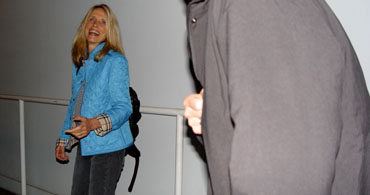
Pamela leaving The Wharf
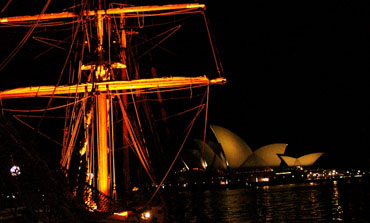
Sydney Opera House
Sunday, May 01, 2005
100 MILLION HEARTS EN ROUTE TO OZ
Arrived in Melbourne around 04.30 this morning, to find BA had lost one of my bags in transit. Apart from anything else, it was the one with all my plugs and cables, making me realise – once again – how umbilically connected one is to the rest of the world, and how truncated when such things go AWOL. Roll on total wirelessness. Arrival takes a little longer than normal – and Murray (Edmonds) puts me in a car into the city with me still having no idea if and when the bag will arrive. But great to see him and, as I tell him, its extraordinary that he would greet a plane at such an uncivilised hour. Still, (Baroness) Barbara Young, another of our speakers was arriving not long afterwards, so it was two birds with one stone.
As flight BA17 flew in across bulldozer-scalped landscapes towards Changhi airport, Singapore, its shadow racing across the cleared areas and green pimpled oil palm plantations, I was just hitting page 181 in Kerri Sakamoto’s astounding book One Hundred Million Hearts (Harcourt 2003). She writes about two sisters in today’s world whose father was a (failed) kamizaze pilot. And the sequence on page 181 is about the Peace Park and museum in Hiroshima. Their reactions – or at least the reactions of the younger sister, Hana – were exactly mine when I visited the city in the 1980s. No sense of the historical context, nothing on the rape of Nanjing, just a story of an aerial holocaust wrought upon innocents.
The current row between the Chinese and Japanese about sanitised Japanese history books underscores the issue.

